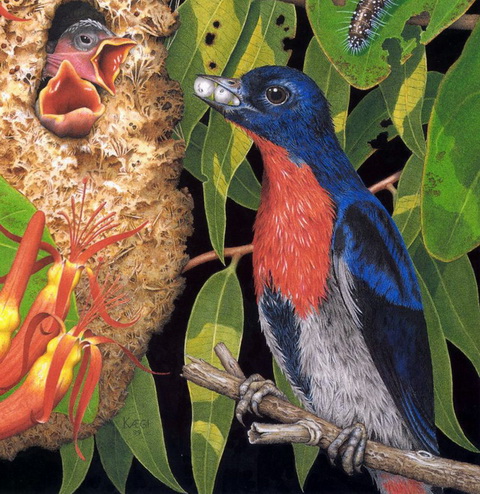|
| Query: Blue peafowl | Result: 186th of 187 | |
Mistletoebird (Dicaeum hirundinaceum) - Wiki
| Subject: | Mistletoebird (Dicaeum hirundinaceum) - Wiki
| |

| Resolution: 480x494
File Size: 138646 Bytes
Date: 2007:09:01 03:36:38
Upload Date: 2007:09:01 03:41:40
|
Mistletoebird
From Wikipedia, the free encyclopedia
The Mistletoebird Dicaeum hirundinaceum is a flowerpecker type bird that mainly lives in Australia, but it can't live in some parts of this country due to arid climates. They are also found in some places of Papua New Guinea, and eastern Indonesia. They also must live where there are trees and shrubs, so that they can build their nests. The bird eats a variety of different foods such as berries and assorted types of insects. When it comes to parenting the male and female both have different jobs.
Appearance
Female and male Mistletoebirds do not look similar. Like a peacock, the male is more striking to look at. The male is blue-black, has a red chest and a slight red undertail, and a black center stripe running down its white belly. The female is less vibrant compared to the male. The female is dark grey, with only a light grey belly and just a touch of red under the tail. This bird is only 10-11cm in size.
Food
The Mistletoebird eats a variety of different foods. Most commonly it eats the berries of the mistletoe plant, hence the name. It also has been found eating nectar, pollen, spiders, and insects in order to balance its diet. During harvest season the mistletoe bird eats grapes and vines of whose leaves have fallen off.
Home
The female Mistletoebird builds the nest by herself with no help from the male. The nest is made of crushed plants and spider webs, which holds it together and holds it to the tree. She will lay the eggs in the nest and look after them till they hatch. When they have hatched both parents will feed them.
By eating the mistletoe, this bird is able to spread the seeds, which is a parasitic plant. When the birds eat the berries, the seeds pass through them, which takes anywhere from 4-25 minutes. Then when they excrete the seeds, they are sticky and stick to the branch of a tree and sprout.
http://en.wikipedia.org/wiki/Mistletoebird
| The text in this page is based on the copyrighted Wikipedia article shown in above URL. It is used under the GNU Free Documentation License. You may redistribute it, verbatim or modified, providing that you comply with the terms of the GFDL. |
|
Comments |
|---|
| | Guest |
|
| Mistletoe Bird, Mistletoebird (Dicaeum hirundinaceum) |
^o^
Animal Pictures Archive for smart phones
^o^
|
|
|

